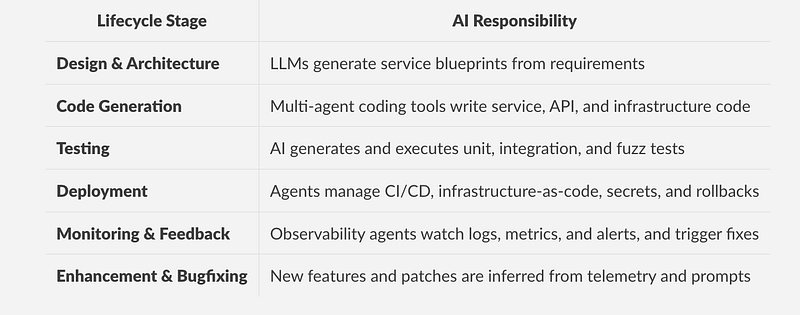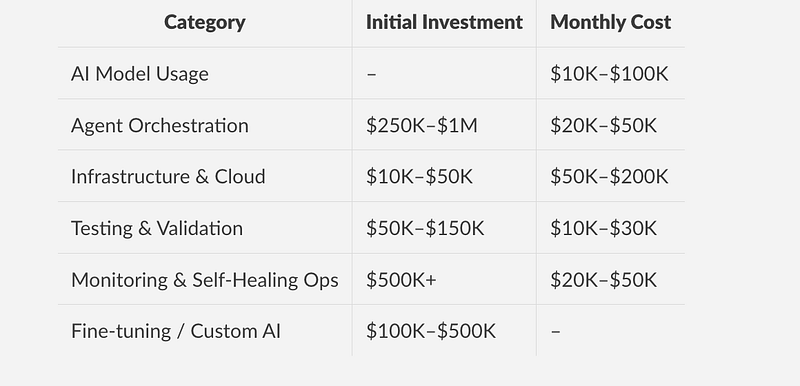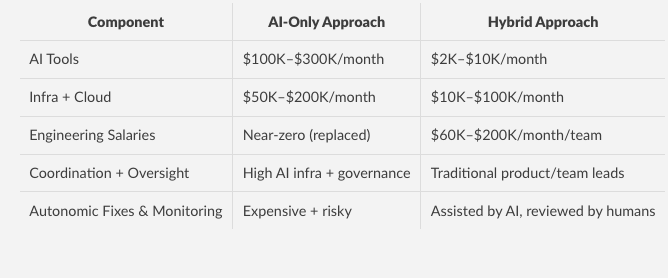What’s the Real Cost of Building a Production-Grade System Using Only AI?
The dream of building software using only artificial intelligence is no longer science fiction. Tools like GPT-4, Claude, and open-source…

The dream of building software using only artificial intelligence is no longer science fiction. Tools like GPT-4, Claude, and open-source coding agents are already producing decent scaffolds of real applications. But let’s step beyond the hype and ask a serious question:
What would it actually cost to build, run, and maintain a production-grade, distributed system entirely through AI — without hiring a single developer?
This post explores that question in detail, cutting through the optimism to reveal what you really sign up for when replacing humans with models.
What Only AI Really Means
Let’s clarify: when we say “only AI,” we mean:
- No full-time developers, testers, or ops engineers.
- AI models generate, test, deploy, monitor, and evolve the software.
- Human involvement is limited to high-level prompts, business goals, and supervision, ideally none at all.
Think of this as running a startup powered solely by intelligent agents.
Sounds impressive, right? But this utopia comes with a price — literally.
The Cost Breakdown
Let’s now look at the actual cost of building and running such an AI-driven system.
AI Model Usage
At scale, you’ll be using GPT-4 Turbo, Claude Opus, or open-source alternatives heavily. Estimated cost between $10K - $100K/month. Includes activities like code generation, refactoring, doc generation, design prompt
Agent Orchestration Platform
You would require an agent orchestration platform to coordinate agents that interpret requirements, generate test plans, propose architecture, trigger deployments etc.
You’ll need either a commercial agent framework or build your own.
- Build-your-own: $250K - $1M upfront
- Commercial SaaS: $20K - $100K/year
Cloud Infrastructure
No AI system runs in a vacuum. You still need compute, storage, K8s clusters, CI/CD servers, databases, cache layers, CDN, security tooling, backups
Cost at scale: $50K - $200K/month
Testing and Compliance Automation
AI can generate test cases, but validation, static analysis, and security checks must still be automated.
Setup costs: $50K - $150K
Ongoing costs: $10K - $30K/month
Monitoring & Autonomic Operations
Your system must watch itself, spot regressions,p ropose or even ship patches. Think self-healing systems with agents watching other agents.
Cost to build: $500K+
Monthly Ops: $20K - $50K
Data Collection and Fine-Tuning
Even with state-of-the-art models, you’ll likely need to fine-tune models on domain-specific prompts, real-world telemetry, post-mortem traces etc.
Estimated Cost: $100K - $500K
Total Estimate

Grand Total:
- Upfront: $1M - $2M+
- Monthly: $100K - $300K+
Wait. Is That More Expensive Than Humans?
Yes — for now. Fully AI-driven development is expensive to orchestrate, unreliable without deep supervision, hard to debug due to hallucinations, misalignments, and lack of context.
This isn’t replacing engineers; it’s replacing them with a complex (and expensive) operating system for automating engineering.
The Hybrid Model Is Still King
Instead of replacing developers, the hybrid model augments them. AI handles the mechanical, repetitive, or generative aspects, while humans drive architectural decisions, business logic, context-heavy debugging, and quality control.
AI Model Usage Costs
Range: $500 - $5,000/month per team
Tools like GitHub Copilot, Amazon CodeWhisperer, ChatGPT, or Claude help with code generation, test case suggestions, documentation summaries, prompt-based API design.
Accuracy: Comparatively Higher
Savings: ~ 20 - 50% dev time saved
AI usage is predictable and scoped — no need for continuous background agents
Infrastructure Costs
Same as traditional development, since you’re still deploying on cloud, using CI/CD pipelines, observability tools, etc. But AI helps here too — configuring infra-as-code, optimizing cloud spend
Cloud spend: $10K - $100K/month (depending on scale)
DevOps automation: Higher leverage per engineer
Productivity Gains
AI improves onboarding, refactoring, and code reviews. Developers focus more on design, modeling, and system thinking.
Organizations have reported ~30–60% reduction in boilerplate work, ~25–40% faster pull request cycles, fewer human bugs due to test gen/code suggestion.
Net benefit: Fewer engineers can do more. You still need senior engineers to supervise AI-assisted output
Testing & QA
AI generates unit tests (e.g., CodiumAI, ChatGPT), integration stubs, mutation testing strategies, but the QA teams validate generated logic and edge cases.
Low upfront setup costs, improvements in Regression cycles. Still requires manual signoffs and high-risk path tests.
Monitoring, Observability & Fixes
AIOps tools (Datadog + GPT, New Relic + LLMs) summarize logs, trace anomalies, and assist with root cause analysis. Engineers then validate and act on suggestions.
Faster MTTR. Auto-generated incident reports. Auto-remediation without human approval is risky.
Team Structure & Management
Teams now include Prompt engineers, engineers with deeper domain knowledge, fewer manual testers or boilerplate coders.
This leads to roles that are up-leveled toward decision-making, system shaping, and review Leads to better talent utilization. Less burnout from repetitive work, but requires a cultural and skillset shift.
Total Cost Comparison (Ballpark)

Hybrid Approach wins in cost-efficiency, risk management, and delivery quality.
AI-Only is feasible but expensive, brittle, and high-risk unless your business is building such systems.
Summary
AI Is a Force Multiplier, Not a Replacement (Yet).
The hybrid model lets you ship faster, maintain quality, keep control and upskill your team. Rather than replacing developers, AI writes the first draft, runs tests faster and monitors more observably.
But humans provide the judgment, coherence, and domain relevance needed to make software trustworthy
Disclaimer
The estimates reflect real-world numbers based on publicly available data and projections on top of it. Specific costs will vary depending on:
Use of open-source vs commercial AI models
Number and complexity of agents
Degree of autonomy vs human-in-the-loop
Stringent compliance and safety standards (e.g., fintech or healthcare) would cost more